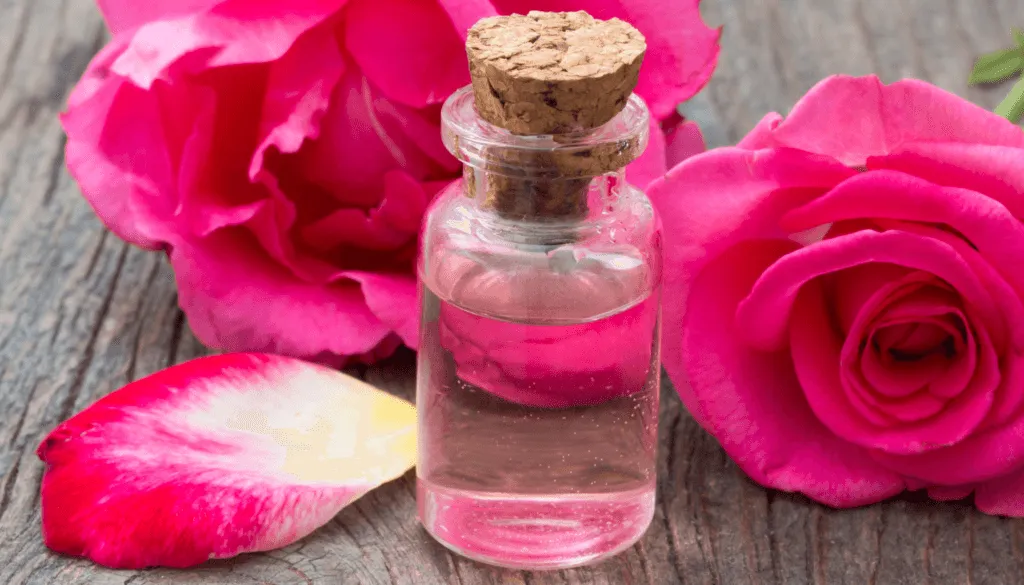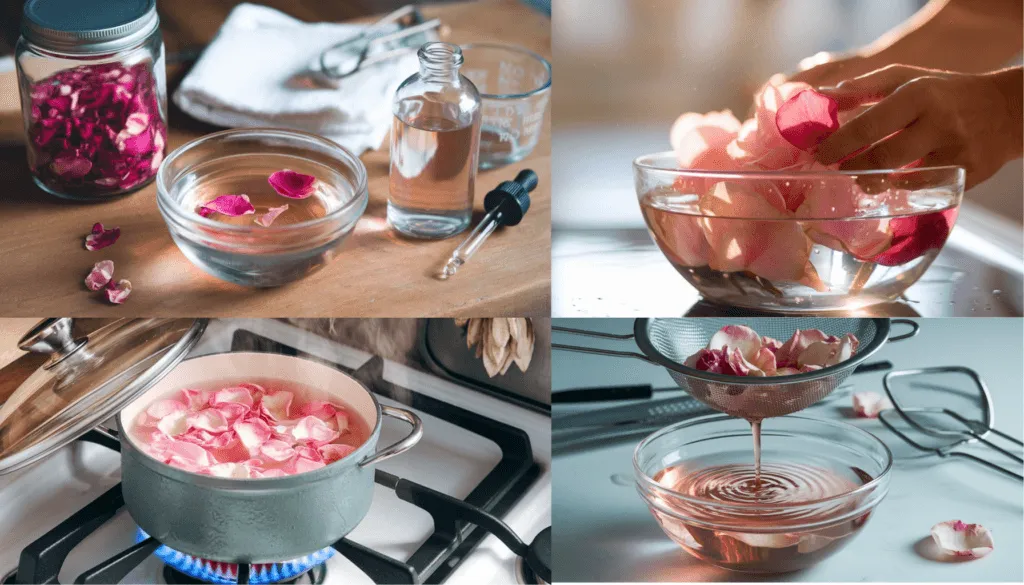I can’t tell you how many videos I watched and recipes I tried before I found the perfect way to make rose water toner at home. I kept running into problems—sometimes it wouldn’t smell quite right, or the color seemed off, and I’d end up with more questions than answers.
Frustrated, I turned to my mom, who’s a bit of a skincare DIY expert herself. She taught me a process that’s simple and effective, and now I’m excited to share it with you. If you’re ready to learn how to make rose water toner at home, I’ve got a step-by-step guide to help you get it just right!
What is Rose Water?
Before we jump into the recipe, let’s talk about rose water itself. Rose water is a fragrant beauty product made by steeping fresh rose petals in water. This process infuses the water with the rose’s beneficial properties. It’s been used for centuries across cultures, not just for its wonderful scent but also for its health and beauty benefits.
For centuries, it was a secret kept by royalty, especially in Middle Eastern and South Asian cultures. Today, it’s a key part of many beauty routines. Its ability to be used in many ways makes it perfect for homemade skincare products.
Rose water is mostly water, with over 99% H2O. This makes it gentle and hydrating for your skin. The remaining 1% has essential oils, vitamins, and other natural compounds from the rose petals. The color of rose water varies based on how it’s made. True rose water from steam distillation is clear. Rose water made by infusing petals in water is often a vibrant pink.
When you make it yourself, you get pure rose water, free from artificial fragrances and preservatives. It’s such a gentle, natural ingredient that even those with sensitive skin can enjoy it.

Benefits of Rose Water
There’s a reason rose water has stuck around for centuries—it’s packed with benefits. Here are just a few I’ve noticed since I started using it regularly:
- Soothes and Calms Skin: Rose water has anti-inflammatory properties that help reduce redness and irritation.
- Hydrates and Refreshes: It acts as a natural hydrator, giving your skin a quick boost of moisture.
- Rich in Antioxidants: The antioxidants in rose water help to protect your skin from damage and keep it looking youthful.
- Balances pH: This toner can help bring your skin’s pH back to a balanced state, which is great for overall skin health.
- Astringent Properties: Rose water can tighten pores, reduce oiliness, and even help prevent acne over time.
Rose Water as a Toner
Rose water is one of the gentlest toners I have used on my skin. I use it twice a day to refresh and hydrate my face. Its mild astringent properties help clear away any leftover dirt or oil without over-drying the skin. Rose water toner is suitable for all skin types, including sensitive skin, and is especially beneficial if you’re looking to balance your complexion naturally.
Step-by-Step Guide: How to Make Rose Water Toner at Home
Ready to learn how to make rose water toner at home? Here’s the process I follow, courtesy of my mom’s tried-and-true method.
Ingredients You’ll Need
- Fresh rose petals: About 1 cup, ideally from organic roses.
- Distilled water: 1-1.5 cups to ensure purity and freshness.
- Strainer: For removing the petals from the water.
- Bottle for storage: A spray or glass bottle works well.
- Optional: A few drops of witch hazel or essential oil for extra benefits.
Instructions
Prepare the Rose Petals
If you have roses from your garden or a florist, make sure to rinse them thoroughly to remove any dirt or bugs. I always choose organic roses or those grown without pesticides to keep the toner as natural as possible.
Simmer the Petals
Place the petals in a small pot and cover them with distilled water. Heat gently—don’t let it boil—just simmer on low. Cover the pot and let the petals steep for about 20-50 minutes. They should start to lose their color as the water turns a beautiful pink.
Strain and Cool
Take the pot off the heat and let it cool down a bit. Use a strainer to remove the petals and pour the liquid into a clean bowl or your storage bottle.
Store the Rose Water
Pour the strained rose water into your spray or glass bottle. At this point, you can add a few drops of witch hazel or your favorite essential oil to customize it further.
Refrigerate
Since homemade rose water doesn’t have preservatives, it’s best to store it in the fridge and use it within two weeks.

How to Use Rose Water
There are so many ways to use rose water toner. Here are some ideas:
Facial Toner
After cleansing, spray it on your face or use a cotton pad to apply it evenly. It’ll give you a refreshing, hydrating boost.
Makeup Setting Spray
I love using rose water to set my makeup and keep my skin looking dewy throughout the day.
Hair Rinse
After shampooing, pour a little rose water on your hair for extra shine and a subtle fragrance.
Add to DIY Masks
Mix it with clay or powder masks to give them a hydrating kick.
Enhancing Rose Water with Essential Oils
Essential oils can add even more benefits to your rose water toner. Here are some of my favorites:
- Lavender Oil: Known for its calming properties, it’s perfect for sensitive skin.
- Tea Tree Oil: Great for acne-prone skin, thanks to its antibacterial properties.
- Geranium Oil: Helps with skin elasticity and adds a lovely floral note.
Remember, essential oils are potent, so only use a couple of drops. It’s always a good idea to do a patch test first to make sure your skin reacts well to the combination.
Rose Water for Skin Health
Rose water is packed with benefits for our skin. It fights inflammation and protects against damage. It’s great for acne, rosacea, and eczema, making skin look better.
It also tightens pores and controls oil. Plus, it keeps skin hydrated and balanced. This makes skin look healthy and shiny.
Rose Water’s Skin-Nourishing Benefits
Using rose water for skin offers many advantages:
- It reduces acne and rosacea redness and inflammation.
- It tightens pores and controls oil.
- It hydrates and balances skin pH.
- It protects against free radicals.
- It soothes and calms sensitive skin.
Rose water is gentle yet effective. It perfect for many skin types and concerns.
How Do I Store Homemade Rose Water Toner?
One of the key advantages of making rose water toner at home is its purity. But without preservatives, homemade rose water toner has a shorter shelf life. I store mine in the refrigerator, where it stays fresh for about two weeks.
To make sure it lasts, always use clean hands or cotton pads when handling it, and keep it tightly sealed. Don’t forget to keep the toner in a dark place or in a container that blocks out light to protect the beneficial compounds in the rose water.
Summary
Making rose water toner at home is a simple process that can transform your skincare routine. With just a few ingredients, you’ll have a refreshing, hydrating toner that smells divine and offers numerous benefits for your skin. Not only is it cost-effective, but it’s also a natural way to pamper yourself. I hope you’ll give this DIY a try and see how it can elevate your beauty routine!
Frequently Asked Questions
Q: Can I use dried rose petals instead of fresh ones?
A: Yes, you can. Use about half a cup of dried petals and follow the same steps as above.
Q: Is rose water toner suitable for sensitive skin?
A: Yes, rose water is very gentle, but it’s always good to do a patch test first.
Q: Does rose water toner help with acne?
A: Yes, rose water’s mild astringent and anti-inflammatory properties can help reduce acne and soothe redness.
Q: How often should I use rose water toner?
A: Twice a day, morning and night, works best for most skin types.
Q: Can I add other ingredients to my rose water toner?
A: Absolutely! Witch hazel, aloe vera, and various essential oils make excellent additions.
Recourses

